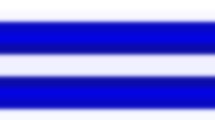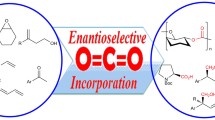Abstract
A novel and green method for the synthesis of dimethyl pyridine-3,5-dicarboxylate has been developed. It is PdCl2-catalyzed heterocyclotrimerization of methyl acrylate with urea in methanol/supercritical carbon dioxide. The target compound was obtained with a 75% isolated yield under the optimized conditions.
Similar content being viewed by others
References
Park J S, Yeom C E, Choi S H, Ahn Y S, Ro S, Jeon Y Ho, Shin D K, Kim B M. An efficient synthesis of 3(S)-aminopiperidine-5(R)-carboxylic acid as a cyclic β,γ′-diamino acid. Tetrahedron Lett, 2003, 44(8): 1611–1614
Bennasar M L, Zulaica E, Roca T, Alonso Y, Monerris M. A synthetic entry to 3,5-disubstituted pyridines. Tetrahedron Lett, 2003, 44(25): 4711–4714
Collman J P, Decreau R A, Costanzo S. Appending a tris-imidazole ligand with a Tyr244 mimic on the distal face of bromoacetamidoporphyrin. Organic Lett, 2004, 6: 1033–1036
Simona V, Pierre G P. Linear multinuclear RuII photosensitizers. Eur J Inorg Chem, 2004, 8: 1763–1769
Wang Z Y, Jiang H F, Ouyang X Y, Qi C R, Yang S R. Pd(II)-catalyzed acetalization of terminal olefins with electron-withdrawing groups in supercritical carbon dioxide: selective control and mechanism. Tetrahedron, 2006, 62(42): 9846–9854
Jiang H F, Shen Y X, Wang Z Y. A simple PdCl2/O2/DMF catalytic system for highly regioselective cyclotrimerization of olefins with electron-withdrawing groups. Tetrahedron Lett, 2007, 48(42): 7542–7545
Jiang H F, Shen Y X, Wang Z Y. Palladium catalyzed aerobic oxidation of terminal olefins with electron-withdrawing groups in scCO2. Tetrahedron, 2008, 64(3): 508–514
Jessop P G, Ikariya T, Noyori R. Homogeneous catalytic hydrogenation of supercritical carbon dioxide. Nature, 1994, 368: 231–236
Burk M J, Feng S, Gross M F, Tumas W. Asymmetric catalytic hydrogenation reactions in supercritical carbon dioxide. J Am Chem Soc, 1995, 117: 8277–8278
Du Y, Cai F, Kong D L, He L N. Organic solvent-free process for the synthesis of propylene carbonate from supercritical carbon dioxide and propylene oxide catalyzed by insoluble ion exchange resins. Green Chem. 2005, 7: 518–523
Jia L Q, Jiang H F, Li J H. Palladium(II)-catalyzed oxidation of acrylate esters to acetals in supercritical carbon dioxide. Chem Commun, 1999, 985–986
Wang Z Y, Jiang H F, Qi C R, Wang Y G, Dong Y S, Liu H L. PS-BQ: an efficient polymer-supported cocatalyst for the Wacker reaction in supercritical carbon dioxide. Green Chem, 2005, 7: 582–585
Kayaki Y, Noguchi Y, Ikariya T. Enhanced product selectivity in the Mizoroki-Heck reaction using a supercritical carbon dioxide-liquid biphasic system. Chem Commun, 2000, 2245–2246
Fujita S, Fujisawa S, Bhanage B M, Ikushim Y, Arai M. Hydroformylation of 1-hexene catalyzed with rhodium fluorinatedphosphine complexes in supercritical carbon dioxide and inconventional organic solvents: effects of ligands and pressures. New J Chem, 2002, 26: 1479–1484
Li J H, Jiang H F, Chen M C. Respective conversion of n-butylamine to methyl N-n-butylcarbamate and oxalbutyline in supercritical carbon dioxide. Green Chem, 2001, 3: 137–139
Cheng J S, Jiang H F. Palladium-catalyzed regioselective cyclotrimerization of acetylenes in supercritical carbon dioxide. Eur J Org Chem, 2004, 643–646
Tkatchenko D B, Picquet M, Solinas M, Franciò G, Wasserscheidc P, Leitnerbc W. Acrylate dimerisation under ionic liquid-supercritical carbon dioxide conditions. Green Chem, 2003, 5: 232–235
Hao J Y, Whitaker M J, Serhatkulu G, Shakesheff K M, Howdle S M. Supercritical fluid assisted melting of poly(ethylene glycol): a new solvent free route to microparticles. J Mater Chem, 2005, 15, 1148–1153
Li J H, Jiang H F, Jia L Q. Glasser coupling reaction in supercritical carbon dioxide. Chem Comm, 1999, 2369–2370
Baiker A. Supercritical fluids in heterogeneous catalysis. Chem Rev, 1999, 99: 453–473
Jawwad A D, Martyn P. New directions in inorganic and metalorganic coordination chemistry in supercritical fluids. Chem Rev, 1999, 99: 495–541
Yee G G, Fulton J L, Smith R D. Fourier transform infrared spectroscopy of molecular interactions of heptafluoro-1-butanol or 1-butanol in supercritical carbon dioxide and supercritical ethane. J Phys Chem, 1992, 96: 6172–6181
Wu W Z, Zhang J M, Han B X, Chen J W, Liu Z M, Jiang T, He J, Li W J. Solubility of room-temperature ionic liquid in supercritical CO2 with and without organic compounds. Chem Comm, 2003, 1412–1413
Fulton J L, Yee G G, Smith R D. Hydrogen bonding of methyl alcohol-d in supercritical carbon dioxide and supercritical ethane solutions. J Am Chem Soc, 1991, 113(3): 8327–8334
Kazarian S G, Gupta R B, Clarke M J, Johnston K P, Poliakoff M. How is hydrogen-bonding influenced by solvent density: The spectroscopic study and modeling of the interaction between a proton donor and acceptor from the gas phase to supercritical fluid states. J Am Chem Soc, 1993, 115: 11099–11109
O’shea K E, Kirmse K M, Fox M A, Johnston K E. Polar and hydrogen-bonding interactions in supercritical fluids: Effects on the tautomeric equilibrium of 4-(phenylazo)-1-naphthol. J Phys Chem, 1991, 95: 7863–7867
Stahl S S. Palladium oxidase catalysis: Selective oxidations of organic chemicals by direct dioxygen-coupled turnover. Ang Chem Int Ed, 2004, 43: 3400–3420
Wang J R, Deng W, Wang Y F, Liu L, Guo Q X. New advances in palladium-catalyzed aerobic oxidations. Chin J Org Chem, 2006, 26: 397–412
Cherbuliez E, Landolt F. The acidolysis of amides. I. The acidolysis of amides of carboxylic acids, a new general method for the preparation of amides. Helv Chim Acta, 1946, 29: 1438–1446
Solodovnikov V V, Selemeneva Z I, Strel’tsova S I, Bazakin V I, Kirichenko V P, Platonova V N, Berezina L N. Perfection of technology for commercial production of formamide. 1. Intensification and perfection of formamide production. Vopr Khim Khimich Tekhnol, 1988, 87: 117–122
Author information
Authors and Affiliations
Corresponding author
Additional information
Supported by the National Natural Science Foundation of China (Grant Nos. 20332030, 20572027, 20625205 and 20772034) and Guangdong Natural Science Foundation (Grant No. 07118070)
Rights and permissions
About this article
Cite this article
Zou, B., Jiang, H. PdCl2-catalyzed heterocyclotrimerization in MeOH/scCO2: A versatile approach to dimethyl pyridine-3,5-dicarboxylate from methyl acrylate and urea. Sci. China Ser. B-Chem. 51, 447–451 (2008). https://doi.org/10.1007/s11426-008-0055-y
Received:
Accepted:
Published:
Issue Date:
DOI: https://doi.org/10.1007/s11426-008-0055-y




